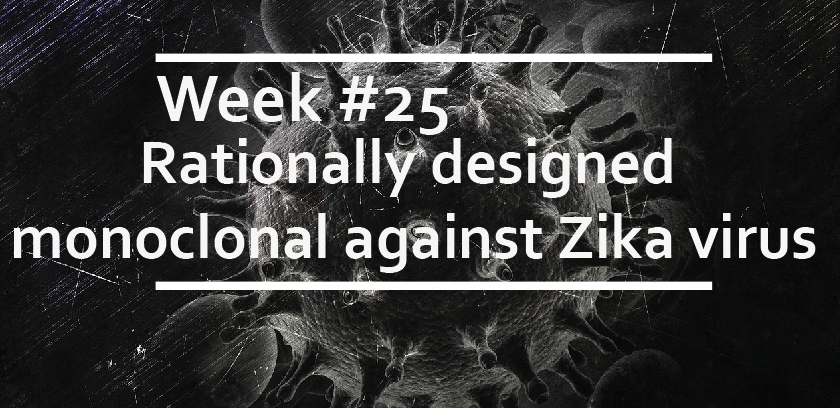Rationally designed monoclonal against Zika virus
Since its re-emergence in 2013, Zika virus (ZIKV) has made the headlines around the world. This was due both to the unexpectedly rapid spread and to the disturbing neurological complication in babies born from women infected during pregnancy. Cases of Zika infection and microcephaly also spilled into western countries, raising awareness of the global health risk brought by emerging flaviviruses.
Despite substantial effort from the scientific community, to date there are no vaccines or antivirals against ZIKV. Studies in mouse show some promise for monoclonal antibody (mAb) therapies, although these strategies don’t come without risks. mAb are generally prone to selecting resistant mutants; additionally, antibodies against flaviviruses are at risk of aggravating subsequent infections in a phenomenon know as antibody-dependent enhancement (ADE). To avoid this, mAbs need to target epitopes that are i) conserved across different viral strains, ii) easily accessible on the viral surface independently of viral “breathing” or other environmental changes, and iii) with limited conformational flexibility. These are the conditions Tharakaraman and colleagues started from to develop a rationally designed mAb.
In vitro correlatives of neutralization
The starting point was to determine experimentally the parameters that best correlate with in vitro neutralisation, using the better-characterised dengue virus (DENV) as a training model. Out of several indicators, including epitope accessibility, antibody occupancy and affinity, the ability of an antibody to engage two or more chains (= interchain locking potential) was identified as the strongest correlative to neutralization. mAbs binding to quaternary epitopes across multiple chains were the most promising. Of these mAbs, the ones targeting intra-dimers epitopes appear particularly promising as they show high degree of conservation and limited conformational flexibility. Based on this information, the authors move on to the rational design of a anti-ZIKV mAbs.
From DENV to ZIKV
Combining computational approaches based on a 3D model of soluble ZIKV E with neutralisation assays the authors confirm the importance of the interchain locking potential and determine that the best antibodies block the E-DII domain of one E monomer (involving the fusion loop) and a small portion of the E-DI and E-DIII regions of different monomers. This epitope, called FLEP (fusion loop epitope proximal region), is present in 180 copies on the virus surface, and is highly available for binding. FLEP also appears not to change in different pH-sensitive viral forms, suggesting that a mAb targeting it should theoretically recognize it also in the acidic environment inside the endosome. This is potentially very interesting, as by blocking or hindering the conformational changes required for viral fusion in the endosomal compartment, these antibodies could avoid ADE. The logic is that even if the antibody were to enhance virus internalization (as suggested by the ADE theory), fusion, the next step necessary for viral infection, would still be prevented.
ZAb-FLEP
This study led to the design of ZAb-FLEP, a mAb able to bind and neutralize all three ZIKV strains tested: MR766, H/PF/2013, and PF13 with PRNT50 ranging from 0.022 to 5.098 mg/ml, revealing better neutralisation activity than other antibodies tested despite a lower binding affinity. The same antibody appears to also neutralize all serotypes of DENV, although in a weaker manner.
Tested at 1.7mg/kg in the IFN-I/II receptor deficient A129 mice infected with 103 pfu of ZIKV one day before or after infection, the antibody protected mice for 30 days after infection, while controls all died at day 10. Importantly, no ADE was observed even at concentrations as low as 0.2mg/kg. Also, ZAb-FLEP reduced placental and fetal infection in pregnant females and no death or abnormalities were observed in the progeny.
How does it work?
A 9.7A cryo-EM structure was next defined for ZAb-FLEP bound to ZIKV. The structure revealed 120 antibodies bound around the icosahedral 2-fold and 3-fold axes, but none around the 5-fold axes. This is because the topological nature of the antibody combined with the different arrangement of the E protein near the different icosahedral vertices restricts occupancy to less than the expected 180 sites. This also suggests that complete occupancy is not necessary for neutralisation. The authors suggest that the two Fab regions of a single IgG may contact separate epitopes near the 2-fold and 3-fold icosahedral axes, preventing the conformational changes required for fusion.
To test this hypothesis, the authors tested whether ZAb-FLEP can prevent infection of THP1.2S monocytes, a cell line highly permissive to ADE, and saw no infection, suggesting that viral fusion is blocked, although actual internalisation of the virus-Ab complex was not tested.
Importantly, seven viral passages under antibody selection did not generate any escape mutant, suggesting that structural and evolutionary constrains confer resistance against antibody selective pressure.
Outlook
Although mAb therapies have been difficult to transpose from laboratory setting to patients (even from non-human primates) and they still face a number of challenges, antibodies can be rationally designed to enhance efficacy and to provide a better understanding of virus neutralisation. This work in particular puts forward two interesting concepts: that the engagement of multiple chains correlates with in vitro neutralisation more than other parameters; and that ADE can be prevented by designing antibody that specifically inhibit fusion. These are interesting concept also in vaccine design and, as discussed in the paper, likely to be widely applicable to other viruses too. While the mouse models are promising, particularly considering the high lethality of ZIKV in the A129 model, further studies in non-human primates will be necessary to assess the effectiveness of this approach in ZIKV and other flaviviruses control.
At Virology Research Services we test antibodies for their ability to neutralise Zika, dengue, and other flaviviruses. If your project involves vaccine or antibody design, contact us and find out what we can do for your research.




